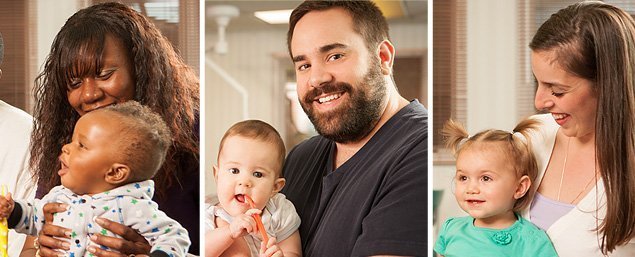





Healthy teeth allow your baby to chew food and talk. They also help shape your baby’s face and hold space open for adult teeth to grow in—adult teeth are bigger than baby teeth, so they need lots of space. When you take care of your baby’s teeth by brushing at home and going for checkups at the dentist, dental visits become a way to prevent cavities instead of just treating them when they happen.
Going to the dentist by age one will help make sure your baby's teeth start healthy and stay healthy. This first visit gives you a chance to ask questions, and it helps your baby start to recognize the dentist and dentist office as a nice place with nice people. It also gives the dentist and you a chance to make sure your baby's teeth and mouth are healthy.
Team up with a dentist now and put your child on the road to a lifetime of healthy smiles!
How to make an appointment. You can find a dentist who sees very young children by asking your child’s regular doctor or by asking friends and family. You can also call your dental insurance company or health insurance company to ask for help in finding a dentist for your child. Once you have found a good dentist, call to schedule an appointment during a time of day when your child is usually rested and cooperative. When you call, ask the receptionist any questions you may have about the visit so that you will know what to expect.
How can I prepare for the first visit? Perhaps the most important thing you can do to make sure the first visit goes smoothly is to help your child know that the dentist’s office is a safe place. If you are nervous about the visit because of some experiences you may have had yourself, your child will pick up on it and be nervous too. Try to stay calm and positive.
Children experience many “firsts” in their young lives. They take their first steps, speak their first words and go for a first haircut. The first dental visit is just one of the many things your baby will do for the first time, and there is a good chance it will be an enjoyable experience.
There are many things you can do to help your child understand what’s going to happen and make her feel more comfortable during the first dental visit:
What to expect at the first visit. A baby’s first visit to the dentist is not like when you visit the dentist. It will be more like what happens at a visit with your child’s regular doctor (without the shots!). Your child can sit in your lap while the dentist faces you and looks inside your baby’s mouth for early signs of cavities. The dentist may need a better look and ask you sit knee-to-knee with the dentist with your baby facing you, and then lean your baby back so that she’s facing you and her head is on the dentist’s lap. This will allow you to make eye contact and hold hands with your baby so she knows she is safe.
Some babies fuss and won’t sit still during their exam, and that’s ok. The dentist and dental hygienist understand children and will be very gentle and patient. With each visit, your child will get used to going to the dentist and will be more relaxed.
When the exam is over, the dentist or the dental hygienist may do a gentle cleaning or take an x-ray of your baby’s mouth. The dentist will also spend time talking to you about foods and drinks that are healthy for teeth, good brushing habits, how fluoride can help teeth stay strong, the potential need for fluoride varnish, and answer any questions you might have about your baby’s teeth and mouth.
At the end of the visit, the dentist will tell you how often your baby should come back. This may be every six months or so depending on your child’s needs. The whole visit should only take about 15 to 30 minutes.
Questions to ask the dentist. It may be helpful to have a list of questions with you to ask the dentist while you’re there. Here are a few things you might want to ask:
Smilestones Photo Tip: Try and take a picture either with your child while at the dentist, or the moments right after – maybe with a sticker! – showing how well you and your child did during this first appointment. Then submit at www.teethfirstri.org/smilestones !
